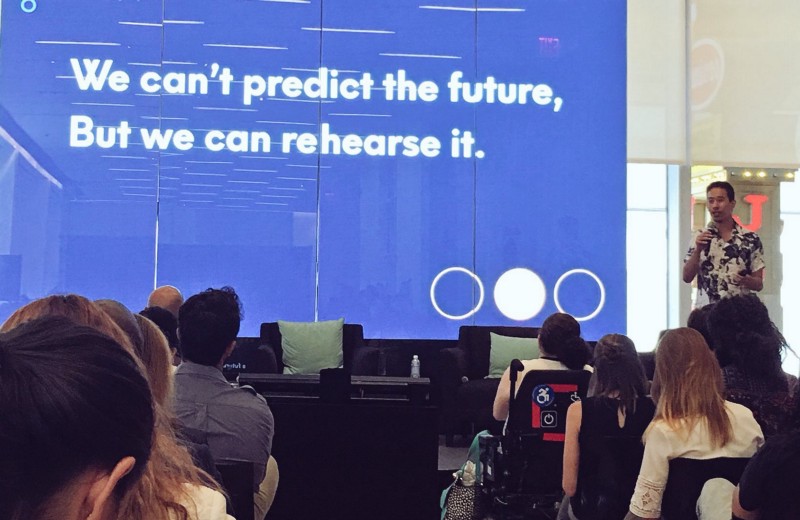“Nobody can predict the future. But we can rehearse for it.”
Introducing a tool to help you plan and design for the future.
You and your team conduct your annual planning meetings. You set your quarterly goals. You rank your priorities for the week. You might even do daily stand-up meetings.
But what about the longer time horizon? Five, ten years down the line? Will your job still exist then? Will your company? Will automation make your industry obsolete? Or could it create new growth opportunities?
Nobody knows the answers to these questions, but we do have tools to help us imagine different possibilities. What’s the worst that could happen? What’s the best? How do we prepare for it?
Lee-Sean Huang speaking about how to bring inclusive futures to life at TechInclusion New York at Viacom, August 2017
Nobody can predict the future. But we can rehearse for it. We can start today to prepare for tomorrow’s world. Prepare for the future of your career or the future of your whole industry.
Futures thinking is an essential skill today for business and design leaders.
As part of our basic preparedness, we practice fire drills. Unfortunately, many of us have even practiced active shooter drills in school or at work. We hear the airplane safety spiel every time we fly. We practice for emergencies, but why don’t we practice for the future?
The future is not inevitable. The future is the product of the choices and the preparation that we make today.
What kind of futures scenarios might you and your organization face ten years in the future? What will you do to prepare for them?
“Ten years is far enough in the future to be beyond the planning horizon of most organizations, yet it is not so far out that it seems unbelievable or irrelevant. Ten years is also far enough ahead to see clear patterns that are not visible in the noise of the present.” — Robert Johansen, Leaders Make the Future : Ten New Leadership Skills for an Uncertain World, 2012
The Foossa Futurecasting Canvas (FFC) is a tool for teams and organizations to model, rehearse, and prepare for the future as part of your core strategic planning and innovation practices.
The FFC is based on our “designing the future” work with organizations ranging from Fortune 500 corporations to city governments to the United Nations. We have also used it to teach at top universities and design schools like the Parsons School of Design at the New School.
We are making the Foossa Futurecasting Canvas available for anyone to use. You can view and download the FFC on Slideshare.
What kind of futures scenarios might you and your organization face ten years in the future? What will you do to prepare for them?
We would love your thoughts on what you think of the Futurecasting Canvasand what we can do to help you design the future. Drop us a line at hello@foossa.com.
Futurecasting Canvas Cheatsheet
Refer to these instructions as a summary for how to use the FFC.
Identify trends and weak signals of interest.
- Identify driving forces behind the trends and weak signals.
- Prioritize 2–3 driving forces to start.
- Map the driving force as a spectrum or continuum: i.e. low to high unemployment, slow to fast technological innovation.
- Plot the top two driving force spectrums on the scenario grid.
- Optional: Mix in additional “Wild Card” or “Black Swan” scenarios
- Build out scenarios from each grid quadrant (and wildcard) using the FFC.
- Start thinking through potential implications and indicators of the scenario based on the driving forces at play.
- Respond with potential actions in response to the scenario.
- Bring the scenario to life with an immersive storytelling sketch. (See video example below)
- Give the scenario a title and logline summary.
- Pose questions for further discussion and investigation.
- Craft a prequel and pre-prequel origin stories to each scenario to understand how they might come to pass.
Futurecasting for Product Innovation
Learn more about futurecasting techniques in our online course on CreativeLive, featuring Foossa cofounder and creative director Lee-Sean Huang.
Ensure Your Organization’s Relevance And Sustainability
We live in a rapidly changing world, and that includes the world of business. To be successful, companies have to develop products and services that not only address the needs of today, but anticipate the needs of tomorrow. That’s why futurecasting is so important.
While no one can see the future, we can model and rehearse potential futures, which is what futurecasting is all about. This essential tool for design innovation and business strategy helps us imagine what the future might be so we can create a long-term vision and make it a reality.
Using techniques adapted from the military, global corporations and top design schools, this course will help you map out the best- and worst-case scenarios of the future and prepare for them.
Learn more and view the futurecasting course on demand.
Bring Future Possibilities To Life
Future possibility stories can help us understand the implications of our design and strategy choices. They are also tangible artifacts that we can use for discussion, debate, and advocacy.
The following "near future" video is part of the Design for Financial Empowerment project that Foossa took part in with the Parsons School of Design, Citi Community Development, and the City of New York. The video shows a possible future for NYC's financial counseling services for city residents. The story brings to life the design interventions that we have proposed and puts them in context.


